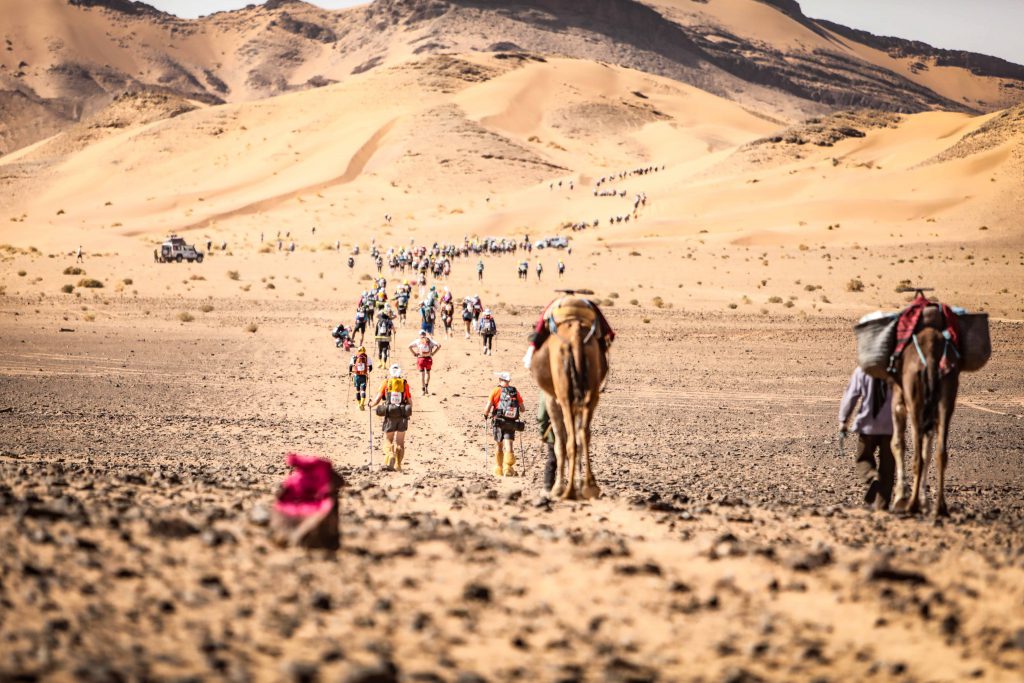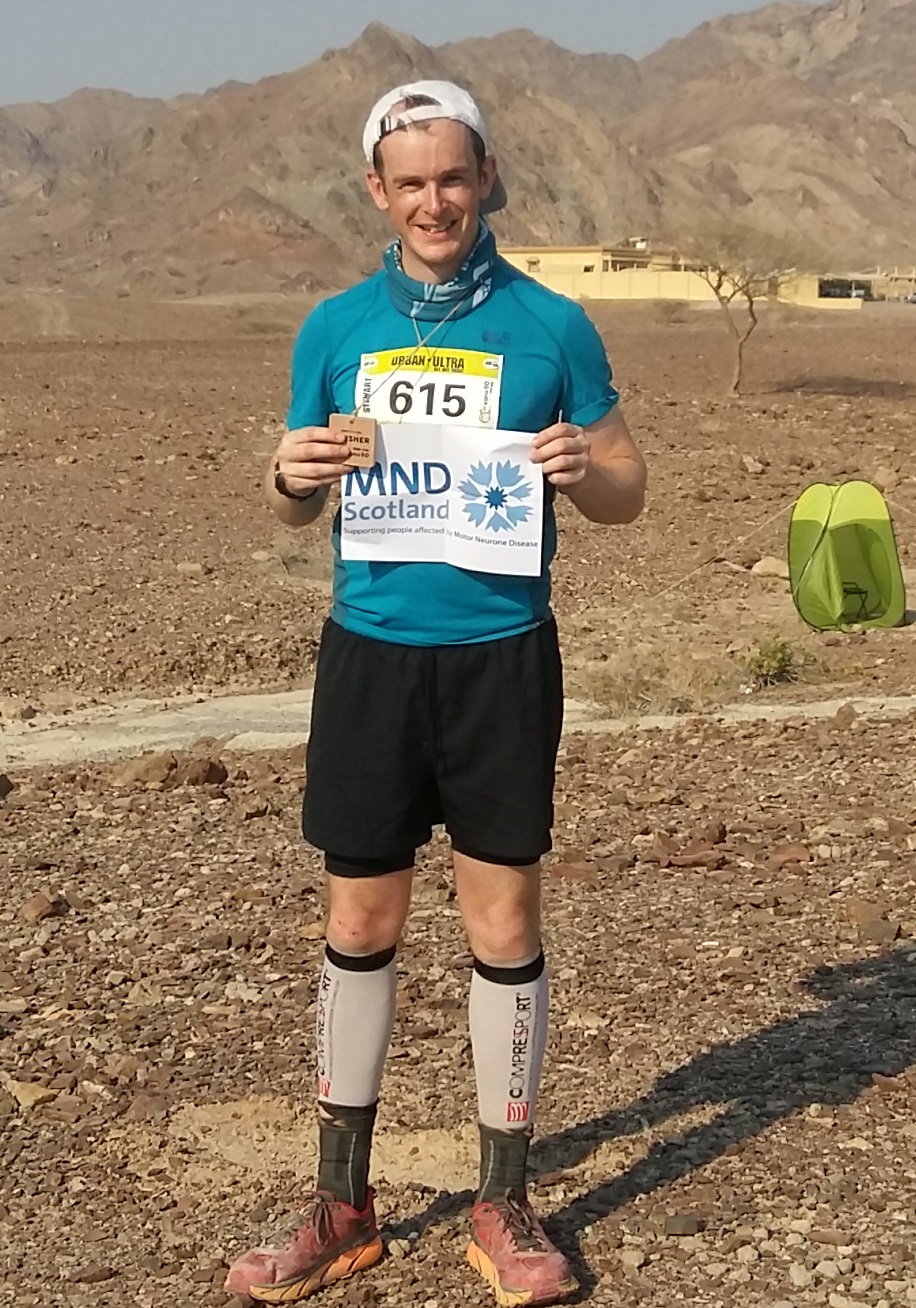What is MND
Find support
I have MND
I am supporting someone
Get involved
Research
About MND Scotland
What’s new?
© MND Scotland 2025
© MND Scotland 2025

 – by Stewart Bell
– by Stewart BellI can’t believe I actually did it. On Friday 13th April, I completed the 33rd Marathon Des Sables, a 6-day ultra-marathon through the Sahara Desert, for MND Scotland.
The 250-kilometre course, the equivalent of Edinburgh to Inverness, is made up of sand dunes, dried river beds, mountains and salt flats in Southern Morocco. The temperatures often reach 50°C and runners, and at times walkers, must carry their entire food supply, sleeping equipment and survival gear – including a flare and a venom pump.
Unsurprisingly, the Marathon Des Sables has earned a reputation as being the toughest footrace on Earth, with some competitors experiencing severe dehydration and in extreme cases, hallucinations, due to exhaustion and the intense weather conditions.
So, naturally, I decided to put myself through this ultimate challenge to raise awareness of Motor Neurone Disease, a condition which has had a profound impact on my family as MND Scotland helped me previously cover.
So now that I’ve made it through, here are some of the toughest physical and mental aspects of the challenge.
A typical race day is challenging from the outset, as temperatures would reach the mid-20s by early morning. We would set off at the start to AC/DC’s ‘Highway to Hell’ blaring out of the PA system at the start line – it’s not exactly the tune I would pick, but at the same time it’s probably the most fitting for the occasion.
There would always be an early burst of pace to cover as much ground during the cooler hours, then you slog it out through the heat until the finish line in the mid-afternoon. Running, walking and scrambling across dried-up riverbeds, shifting sand dunes, rocky desert flats and up and down boulder ravines. The wind mostly in your face, sand in your teeth and the Sun always beating down. The wind was ever present on the open sections but it actually helped keep the heat at bay.
My overall race strategy for the week was simple: try and come out of the first three days relatively unscathed (30km, 40km and 30km distances, respectively) to ensure I was semi-capable of getting through the 86km long stage. Then, if I got through the long stage alive, rest up for one day before throwing everything into the final marathon stage.
Each day brought changing landscapes; mostly awe-inspiring, but always challenging. I was torn at times between wanting stop and appreciate the surroundings or keep on running so I could finish the race. The sentimental side won out on some occasions, mostly at the top of a hill climb where my lungs demanded I take in the view for a few moments.
Finishing each stage felt like a great achievement, and a huge relief, to be one step closer to the eventual finish line. Then, each afternoon took on a familiar pattern: collapse in the tent, raise aching feet up on backpack to let the blood drain out, have a recovery shake then slowly roll over to take my trainers and socks off, hoping my feet would be relatively intact! If they weren’t, hobble over to the medic’s tent, which seemed as though they definitely pitched further away from the main campsite each day.
Back at the tent after having some blisters drained and some red antiseptic injected, I would boil up some water for my food and chat with my tent mates. We could only really laugh at each other and the situation we had gotten ourselves into. A definite gallows humour was the overriding mood of the week.
A sandstorm hit us during the second race night. Sand gusting through our open-sided tent and caking everything in dust proved that we were very much at the desert’s mercy. It’s an unforgiving place at times. Getting up each morning to do it all over again was quite unfathomable, with little sleep gained and body severely aching after a freezing cold night on a stony desert floor.
By some miracle, once I’d shoveled down some rehydrated porridge, strapped on my trainers and backpack, I was ‘good to go’. There was a quick briefing from Patrick Bauer (Race Director and founder of the MDS), a count down from 5, a blast of AC/DC, and off we all went again!
My lowest and also most defining point of the race came on the long stage. At around the 20km point we hit some sand dunes, where the trail led us across the slopes. After 8km this was really tearing my foot up. I kept going to the next checkpoint, refilled with water and set off again. That’s when I realised I was in bad shape – both with exhaustion and a growing agony in my foot. I met two other Brits who were setting a fast marching pace. I decided that if I didn’t join them I probably wouldn’t finish the race, so I tagged along with them and slogged it out.
When we reached Checkpoint 5 at 56km, the Sun was down, the temperature had dropped and my foot was in ribbons. I visited the medic tent, took my sock off and basically the skin on the sole of my foot had ruffled-up along the arch, leaving a blister the size of tennis ball. The medic slit the top of this mass and injected the lovely red stingy stuff as I bit down on my hand. The pain had subdued slightly but I was basically walking on raw flesh at this stage with 30km still to go, starting off with yet more dunes. Every step was excruciating, like walking on hot coals.
We weren’t long out of the checkpoint, so at that point I had a decision to make. Your instinct tells you just get out of there, throw the towel in and go home. But then you think of why you’re there, how you got there, all the hard work and miles you’ve put in and the hopes of everyone following you at home. With that on your mind and a pace set in your legs, by some grace you blank out the pain and just keep moving. I had a similar turning point on a training event earlier in the year, where I knew if I quit at a tough stage of that race, there was no way I could compete in the MDS. It was probably that moment that defined whether I would complete the MDS or not.
At the next couple of checkpoints I had to walk in circles until the others were good to go. The pain was just unbearable if I had to stop and try to start again. Gradually a glint of the finish line appeared on the horizon, a trick the organisers loved to play, giving you hope even though there were still miles to go. No-one was talking now; it was 4am and we were completely blown having been on the road for over 19 hours. The line was in front of us but wasn’t getting any closer, we were tripping over rocks and stumbling into each other, eyes focused on the lights ahead.
The path led down into some undergrowth and the lights vanished for about 15 minutes. When we came out, the line was just metres away. We couldn’t run, instead we just bumbled across it, no celebrations, just straight to our tents and lights out. Waking up the next day everyone looked at each other in disbelief. We had made it through the worst section of the world’s toughest race, and a medal was within our grasp!
Next was Marathon Day: the final stage and a medal waiting for me at the finish line. I’d never run a marathon before, let alone after five days of running other marathons, baked by the Sun, malnourished, sleeping rough and with a gaping wound on my foot. I’d also never started a marathon in a sandstorm, so it was all very new to me. Despite everyone lurching about like zombies at the start line, we shot out of the blocks at a crazy pace. The top 200 runners were starting an hour and a half behind the main pack to ensure everyone finished quite close together.
The first 10km was brilliant, I stayed quite far up in the pack and reached checkpoint 1 in about an hour and 20 mins. After that we came onto a long flat desert section, running head first into gale force winds which forced most of us into a walking pace. After checkpoint 3 it was more sand dunes, which frustratingly worsened my foot condition, and set me up for a slow, painful trek to the finish line. I was dropping places at this point, but on reflection I just wanted to appreciate this last day and soak it in. I’d spent the previous stages just trying to get through them, but I wanted to ‘enjoy’ this one as much as possible!
The final finish line was literally a mirage on the horizon, the final cruel trick on your mind. Crossing the line and getting your medal from Patrick Bauer was a surreal experience. I couldn’t quite believe I’d gotten away with it and achieved something that was unimaginable a few days ago, let alone a year ago when I first signed up. There was a sense of disbelief that it was all finally over (although it wasn’t… I still had an 8km ‘Charity Fun Run’ over more sand dunes the next day so I could get the bus home).
Overall, it was a brutal, grueling race under seriously tough conditions. It wasn’t just the training and strength-of-mind that got me through, it was also the camaraderie with my tent mates and the strangers I met along the way that kept the spirits up and ultimately makes the MDS such a unique and legendary race.
Would I do it again? At this stage I can’t even look at a sand dune without having terrible flashbacks, but one day I might look at doing something similar. You can never re-live such an incredible experience, so I might just leave the MDS box ticked.
If you’d like to sponsor Stewart post-race, you can still do this on Stewart’s Just Giving page.
If you’re interested in taking on a challenge for MND Scotland, please get in touch with us at fundraising@mndscotland.org.uk or give us a call on 0141 332 3903.
Sign up
for newsletter
Get the latest news and events straight to your inbox.
You can help create a world without MND